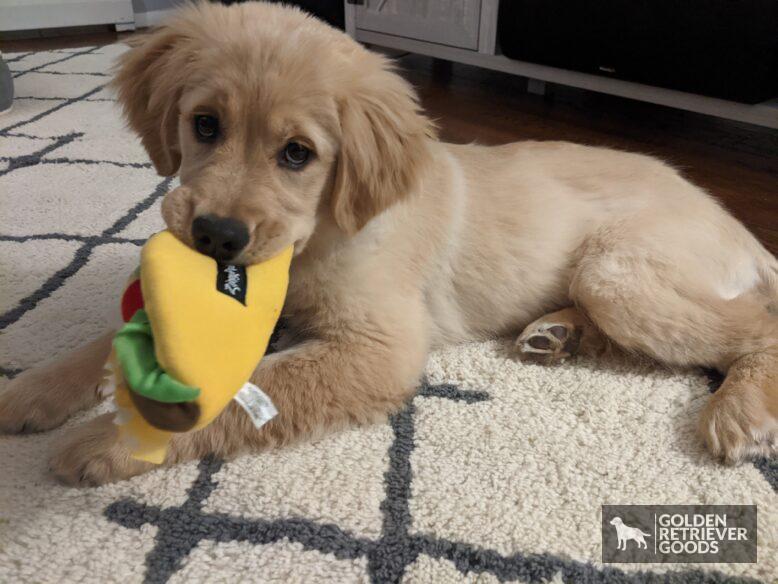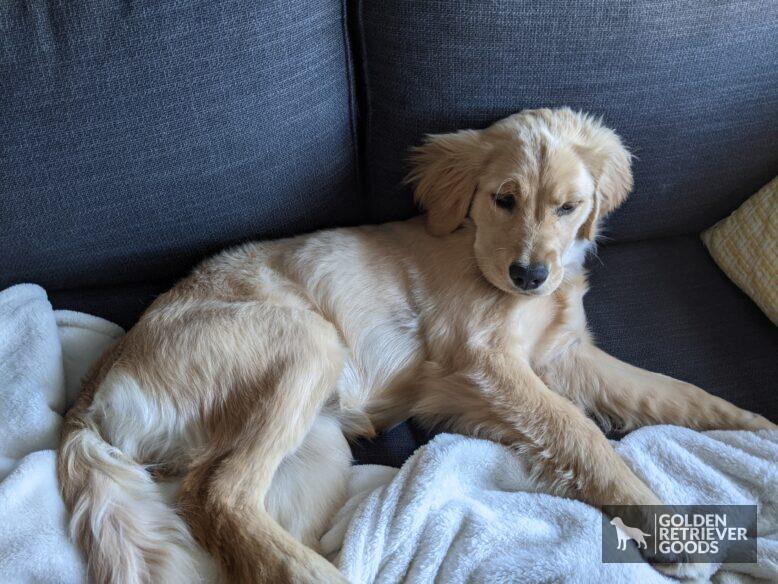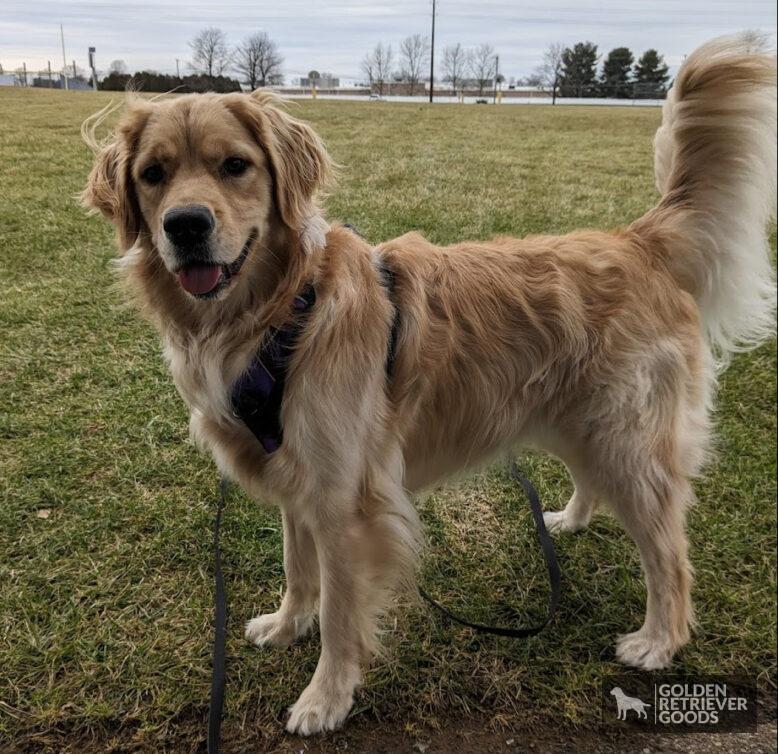Golden Retriever Coat Stages – Full Coat Timeline
Understanding the different stages of a Golden Retriever’s coat is important for their overall health and grooming. In this post we’ll explore the various coat stages of a Golden Retriever along with care tips and what you can expect as your pup moves through each phase!
Golden Retriever Puppy Coat

When Golden Retriever puppies are born, they have fine and soft fur. This puppy coat is designed to keep them warm during their early weeks of life. As your puppy grows older, their coat will start to change in texture and density.
Characteristics of a Puppy Coat
Puppies have a fluffy coat that’s soft with a silky texture – if you’ve ever heard someone talk about “puppy fluff” before, this delightfully fluffy puppy coat is exactly what they meant! It may be lighter or darker than their adult fur color, making it difficult to predict what their final appearance will look like. Luna was an incredibly light puppy for us, but now that she’s an adult she looks just like a typical Golden.
Grooming Tips for Puppies
Proper care during the puppy stage can help prepare your dog for healthy hair growth as they get older. Here are some tips on how to manage puppy fur:
- Brush regularly: Use a soft-bristle brush once every few days to keep tangles away.
- Bath time: Avoid giving too many baths in this stage because it can dry out the skin.
- Diet: Feed your pup high-quality food that contains essential vitamins and minerals needed for healthy fur growth.
Shedding During The Puppy Stage
Golden puppies don’t shed much compared to adults. However, they do lose some fur occasionally as part of normal shedding. Expect extra shedding when transitioning into an adult golden retriever around 6 months old.
Taking proper care of your retriever’s puppy coat ensures healthy fur growth in later stages while also keeping them comfortable throughout their development period.
Golden Retriever Transitional Coat

While you may notice changes in your pup’s fur as early as three months of age, the 6 – 8 month mark is when most Goldens begin going through this first transitional growth stage. Puppy fur falls to make way for new adult fur, and shedding will definitely pick up during this “fluff to fur” stage. Your furry friend may look patchy or uneven for a while until their new hair has had a chance to mature. You’ll notice a combination of short and long hair that contributes to this “awkward teen” look until the thicker coat is fully grown in, usually around the 18 – 24 month mark.
Characteristics of a Transitional Coat
Your pup’s transitional coat will vary depending on genetics and individual differences. However, some common characteristics include:
- A thinning out of the puppy fur
- The development of long guard hairs which make up your pup’s darker outer coat
- Adult hair around the ears and paws
Care Tips for Growing Goldens
Proper maintenance during the transitional phase helps support healthy fur as well as keeps shedding under control. Here are some tips on how to care for your dog as they continue to get long hair coming in:
- Brush regularly: Use a slicker brush to help remove dead hair from both layers.
- Bathe once per month: Frequent bathing can strip away natural oils that keep skin moisturized.
- Diet: Feed high-quality food with essential fatty acids necessary for skin health.
Shedding During The Transitional Phase
Golden Retrievers typically shed more frequently during this stage than they do when they were puppies. This is because they’re losing old fur which makes way for their adult fur to grow in. Be sure you’re using proper grooming techniques such as brushing weekly and bathing monthly.
It’s important to be patient with your dog as their coat grows during this awkward-looking transition period since it may take several months before the new “grown-up” hair comes all the way in. Take it for what it is, another endearing chapter in your pup’s life that you’ll find yourself missing down the road!
Golden Retriever Adult Coat

This is the main stage of a Golden’s coat development. At this point, their fur should be dense, glossy and fully grown in. Proper fur care during this phase ensures that your dog stays comfortable while also maintaining the health of their skin and hair. A mature golden coat is the hallmark look of the breed that everyone knows and loves!
Characteristics of a Mature Coat
A healthy adult coat has two layers: A longer outer coat and a shorter inner layer that keeps them warm. Additionally:
- The fur color should be rich with no bald spots.
- Their undercoat will become thicker as they mature.
Grooming Tips for Adult Goldens
Playing hairdresser for your Golden Retriever regularly can help maintain healthy and shiny hair throughout adulthood. Here are some tips on how to care for them at this stage:
- Brush daily: Use a slicker brush or comb to remove any tangles from both layers.
- Bathe every 2 months: Regular bathing helps control odor without drying out their skin.
- Diet: Feed high-quality food with essential fatty acids necessary for skin health.
Shedding During The Adult Stage
Golden Retrievers shed more heavily twice per year during seasonal changes in spring/fall which is called “blowing” or shedding season. You can expect heavy shedding sessions lasting several weeks followed by less frequent shedding periods afterward if you take proper care of the dog’s diet, hygiene, exercise needs etc.
Overall, taking good care of your dog’s adult fur requires regular maintenance such as brushing daily and providing a balanced diet with plenty of water intake so that they stay hydrated all year round!
Golden Retriever Senior Coat
As Golden Retrievers age, their fur will start to change along with the rest of their body. Proper brushing and bathing during this stage is essential for maintaining healthy skin and hair while also keeping your dog comfortable as they grow older.
Characteristics of a Senior Coat
Senior Golden fur may become thinner or lose density as they age, just like most people experience some level of hair loss as they get older. Additionally:
- Their fur may turn gray in color.
- A reduction in oil production can cause dry, flaky skin.
Care Tips for Senior Goldens
Grooming an aging dog requires special care to keep them comfortable and maintain healthy skin & hair. Here are some tips on how to care for a senior golden’s fur:
- Brush regularly: Use soft-bristled brushes that won’t irritate sensitive skin.
- Bathe once every 2 months: Use lukewarm water and gentle shampoo designed for dogs with sensitive or dry skin.
- Diet: Feed high-quality food rich in Omega 3s for joint health but not too much protein because the kidneys don’t work as well over time.
Shedding During The Senior Stage
Golden Retrievers shed less frequently at this stage though there might be more shedding than usual due to hormonal changes related to aging. Regular brushings can help manage shedding effectively by removing any loose hair from both layers of fur without causing pain or discomfort.
Taking good care of your pet’s aging head of hair involves regular brushing and providing a balanced diet with plenty of water intake so that they stay hydrated all year round!
Grooming Your Golden Retriever
Maintaining healthy fur for your pup is crucial for their overall well-being. A healthy coat not only looks shiny and beautiful but also serves as an indicator of your dog’s general health. Golden Retrievers are heavy shedders and do require a non-trivial amount of upkeep and care throughout their life.
Nutrition
A balanced diet that includes all essential nutrients promotes a healthy coat. Some important nutrients for maintaining a healthy coat include:
- Omega-3 Fatty Acids: Promotes skin health, reduces inflammation.
- Protein: Provides necessary amino acids to promote fur growth.
- Vitamins & Minerals: Essential building blocks for proper body function.
Hydration
Proper hydration is critical in keeping your dog’s skin moisturized and supple. Make sure they have access to clean water at all times and consider adding moisture-rich foods like canned food or broth if needed.
General Golden Retriever Coat Care
Regular upkeep play a significant role in promoting a healthy coat throughout all stages of life. Here are some habits you can adopt:
- Brush regularly: Helps distribute natural oils while removing dead fur from both layers.
- Bathe when needed: Use gentle shampoo designed specifically for dogs with no harsh chemicals that can cause dryness or irritation
- Avoid over-bathing since it washes away natural oils leaving the skin vulnerable to irritants.
Skin Conditions
Some common skin conditions affecting Golden Retrievers include allergies, hot spots, dandruff or seborrhea (oily flaking). If you notice any abnormal changes in your dog’s coat such as excessive shedding, bald patches, or redness on the skin consult with veterinarian promptly.
Conclusion
Understanding the different stages of your Golden Retriever’s coat is essential for maintaining their health and appearance. Each stage comes with its unique characteristics, requiring specific grooming habits to keep them comfortable and healthy.
Importance of Consistent Upkeep
Proper brushing and bathing practices help prevent matting, skin irritation, and other related issues that can cause discomfort or pain in your pet. Good hygiene habits also reduce shedding while promoting a shiny, healthy coat throughout all stages of life.
The Role Of Nutrition And Hydration
A balanced diet rich in Omega-3 fatty acids along with adequate hydration levels promote healthy skin and hair growth. Feeding high-quality food provides necessary nutrients while keeping them hydrated through access to clean water at all times.
Monitoring Health Conditions
Monitoring changes in your dog’s coat such as excessive shedding or bald patches helps identify potential underlying health problems early on so you can take action promptly. Regular veterinary checkups ensure any developing problems are addressed before they become serious concerns.
By following an established care routine tailored to each stage of their life cycle combined with proper nutrition/hydration intake monitoring; you can maintain a beautiful shining coat throughout all phases while ensuring optimal overall wellness!
Frequently Asked Questions
When Do Golden Retrievers Get Their Full Coat?
Most golden retrievers get their full coat between 18 and 24 months of age. That being said, there is no universal timeframe. Some will get their adult coat sooner than 18 months, and some will take longer than 24 months.
Related Reading
- What Health Problems Do Golden Retrievers Have?
- How Intelligent Are Golden Retrievers?
- What Do Golden Retrievers Like to Do?
- When Should Golden Retrievers Be Neutered?
- How Much Should Golden Retrievers Weigh?
We want to remind our readers that the articles or content found on goldenretrievergoods.com do not constitute nor replace professional veterinary advice, diagnosis, or treatment. The information provided on our website is purely educational and informational, and should not be used as a substitute for advice from a licensed veterinarian.

